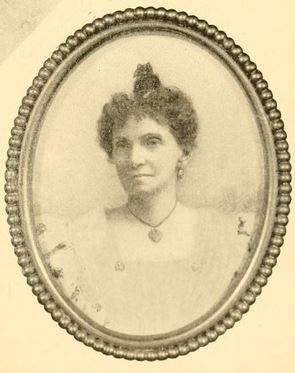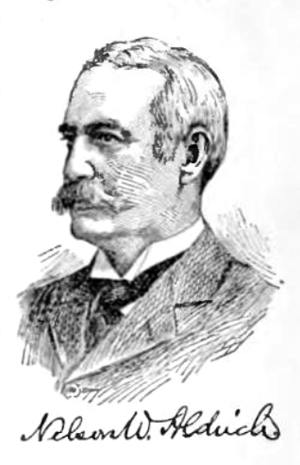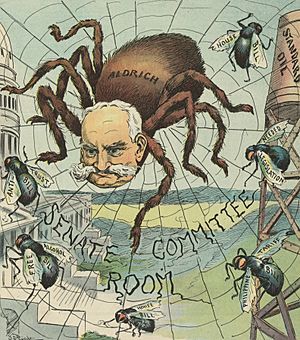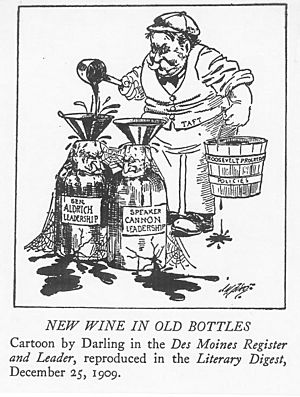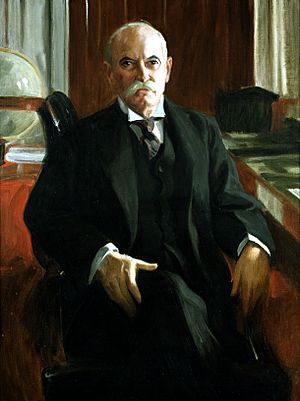Nelson W. Aldrich facts for kids
Quick facts for kids
Nelson W. Aldrich
|
|
|---|---|
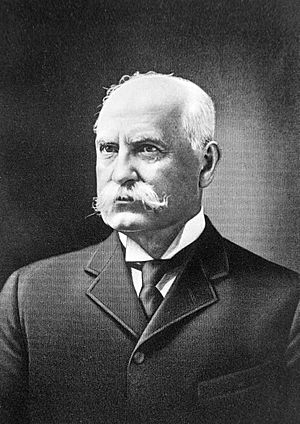 |
|
| United States Senator from Rhode Island |
|
| In office October 5, 1881 – March 3, 1911 |
|
| Preceded by | Ambrose Burnside |
| Succeeded by | Henry F. Lippitt |
| Member of the U.S. House of Representatives from Rhode Island's 1st district |
|
| In office March 4, 1879 – October 4, 1881 |
|
| Preceded by | Benjamin T. Eames |
| Succeeded by | Henry J. Spooner |
| Member of the Rhode Island House of Representatives | |
| In office 1875–1876 |
|
| Personal details | |
| Born |
Nelson Wilmarth Aldrich
November 6, 1841 Foster, Rhode Island, U.S. |
| Died | April 16, 1915 (aged 73) New York City, U.S. |
| Resting place | Swan Point Cemetery |
| Political party | Republican |
| Spouse | Abigail Pearce Truman Chapman |
| Children | 11 |
| Alma mater | East Greenwich Academy |
| Profession | Businessman |
| Military service | |
| Allegiance | United States Union |
| Branch/service | United States Army Union Army |
| Years of service | 1862 |
| Rank | Private |
| Unit | 10th Rhode Island Infantry |
| Battles/wars | American Civil War |
Nelson Wilmarth Aldrich (born November 6, 1841 – died April 16, 1915) was a very important American politician. He was a leader of the Republican Party in the United States Senate. He represented Rhode Island in the Senate from 1881 to 1911.
By the 1890s, he was part of a group called the "Big Four." These were four key Republicans who made most of the big decisions in the Senate. Because of his influence, people called him the "general manager of the Nation." He was very powerful in setting rules for tariffs (taxes on imported goods) and how money worked in the country.
Aldrich was born in Foster, Rhode Island. He served in the Union Army during the American Civil War. After the war, he became a successful businessman. He then started his political career in the Rhode Island House of Representatives.
He later served in the United States House of Representatives before becoming a Senator. In the Senate, he helped create a system of tariffs. These tariffs protected American businesses and farms from foreign competition. He also helped pass the Payne–Aldrich Tariff Act. He played a key role in getting the 1898 Treaty of Paris approved. This treaty officially ended the Spanish–American War.
Aldrich also led the creation of the Aldrich–Vreeland Act. This law set up the National Monetary Commission. This group studied why the Panic of 1907 (a financial crisis) happened. Aldrich led this commission. They created the Aldrich Plan, which helped create the Federal Reserve System in 1913. This system manages the country's money and banks. Aldrich also supported the Sixteenth Amendment. This amendment allowed the government to collect a federal income tax.
Aldrich believed his financial policies would make the country more efficient. However, some people criticized him. They saw him as someone who helped big businesses too much. His daughter, Abigail, married John Davison Rockefeller Jr., whose father was John D. Rockefeller, a very rich businessman. Many of Aldrich's descendants became important in American politics and banking.
Contents
Early Life and Family
Nelson Aldrich was born in Foster, Rhode Island. His family was not wealthy. His father, Anan E. Aldrich, worked in a mill. His mother was Abby Burgess.
He went to public schools in East Killingly, Connecticut. He also attended East Greenwich Academy, a boarding school in Rhode Island.
Starting His Career
Aldrich's first job was working for the biggest wholesale grocery store in Rhode Island. He worked hard and eventually became a partner in the company.
He served for a short time in the Union Army during the American Civil War. He joined as a private in 1862. His unit served for three months near Washington, D.C.
In 1866, he married Abigail Pearce Truman "Abby" Chapman. She came from a wealthy family. They had eleven children together.
Aldrich became interested in politics. He started debating political issues in public. He also became a director of a small bank in Providence.
Early Political Steps
Nelson Aldrich began to have a big impact on Rhode Island politics by 1877. He was a member of the Providence City Council from 1869 to 1875. He was even its president in 1872 and 1873.
He was then elected to the Rhode Island House of Representatives as a Republican. He served from 1875 to 1876. In 1876, he became the Speaker of the House.
Becoming a U.S. Senator
In 1878, Aldrich was chosen by the Republican leaders in Rhode Island to run for the U.S. House of Representatives. He won and served one term, from 1879 to 1881.
In 1881, the Rhode Island legislature elected him to the U.S. Senate. He served in the Senate for 30 years, from 1881 to 1911. He was the longest-serving U.S. Senator from Rhode Island for many years.
Aldrich focused on national tariff issues when he joined the Senate. He believed tariffs were important for businesses and ordinary people. He often talked to business leaders about tariffs.
By the 1890s, he was one of the "Big Four" Republicans who controlled many Senate decisions. The others were Orville H. Platt, William B. Allison, and John Coit Spooner. Aldrich's main power came from leading the Senate Finance Committee. This committee handled bank rules and money policies.
Aldrich became a millionaire through his business dealings. He was against using silver to back currency. He helped convince President William McKinley to support a gold-backed currency in 1896.
National Money Policies
Aldrich was very important in discussions about money in Congress. After the Panic of 1907 (a financial crisis), the Aldrich–Vreeland Act was passed in 1908. This law created the National Monetary Commission, which Aldrich led.
The commission wrote many reports. They then created the Aldrich Plan. This plan became the basis for the Federal Reserve system, which helps manage the nation's money.
Aldrich also helped write the Payne–Aldrich Tariff Act of 1909. This law removed import taxes on fine art. This made it easier for Americans to bring expensive European artworks into the country. Many of these artworks became part of major museums.
In 1909, Aldrich introduced a plan for a constitutional amendment to create an income tax. This was surprising because he had called a similar idea "communistic" years earlier. He actually supported the corporate tax to try and stop the income tax from happening.
The plan passed in the Senate and the House. The corporate tax was put in place. The income tax amendment was sent to the states for approval. Many thought it would not pass.
Aldrich also led the Senate Republican Conference. He chaired several important committees during his time in the Senate. These included the committees on Finance, Rules, and Transportation Routes to the Seaboard.
Creating the Federal Reserve
After the Panic of 1907, Aldrich became the chairman of the National Monetary Commission. He believed in making things more efficient and using expert knowledge. He led a group of experts to study how national banks worked in Europe.
He learned that countries like Britain, Germany, and France had much better central banking systems. He worked with important bankers and economists to create a plan for an American central bank in 1911. This work included a secret trip to Jekyll Island in 1910 to finish the details of the plan.
In 1913, President Woodrow Wilson signed the Federal Reserve Act into law. This law was based on Aldrich's ideas. It created the modern Federal Reserve System, which is still very important today.
Foreign Relations
Aldrich did not want the U.S. to enter the Spanish–American War at first. But once the war started, he supported President McKinley. He was key in getting the Treaty of Paris approved by the Senate. This treaty ended the war and led to the U.S. taking control of the Philippines.
He also helped create the Platt Amendment in 1901. This amendment set out the U.S. role in Cuba. He supported the Panama Canal project.
In 1906, Aldrich and other American financiers invested in mines and rubber in the Belgian Congo. They supported King Leopold II of Belgium, who had very harsh labor conditions in the colony.
Famous Family Members
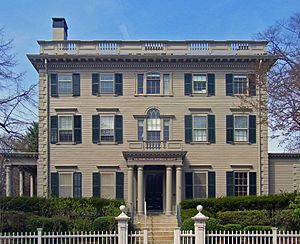
Nelson Aldrich's daughter, Abigail Greene "Abby" Aldrich, was a generous person who gave money to good causes. She married John Davison Rockefeller, Jr.. He was the son of John D. Rockefeller, who helped start Standard Oil.
Their second son, Nelson Aldrich Rockefeller, was Governor of New York for four terms. He also tried to become President. In 1974, he became Vice President of the United States under President Gerald Ford.
Aldrich's son Richard S. Aldrich served in Congress. Another son, Winthrop Williams Aldrich, became the chairman of the Chase National Bank. His grandson David Rockefeller also became a leading banker. The American film director Robert Aldrich was also his grandson.
Other Interests
Aldrich was very active in the Freemasons, a social organization. He was the Treasurer of the Grand Lodge of Rhode Island.
He also built a large country estate in Warwick, Rhode Island. This estate is now known as the Aldrich Mansion. It is owned by the Roman Catholic Diocese of Rhode Island.
Death and Burial
Nelson Wilmarth Aldrich died on April 16, 1915, in New York City. He was buried in Swan Point Cemetery in Providence, Rhode Island.
Legacy
The Nelson W. Aldrich House in Providence is now the main office for the Rhode Island Historical Society.
The Aldrich Middle School in Warwick, Rhode Island, is named after him.
Aldrich Residence Hall at The University of Rhode Island is also named in his honor.
Aldrich Hall at Harvard Business School was built with a gift from John D. Rockefeller. It is named after Nelson W. Aldrich, his father-in-law.
Images for kids
See also
 In Spanish: Nelson W. Aldrich para niños
In Spanish: Nelson W. Aldrich para niños


